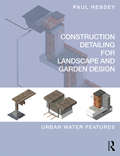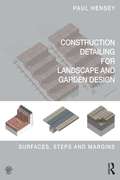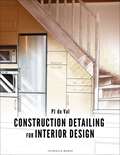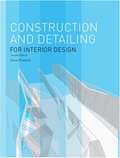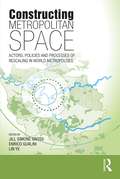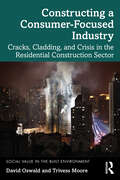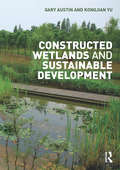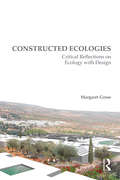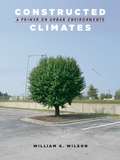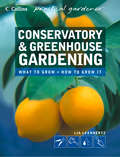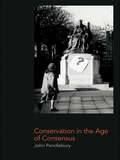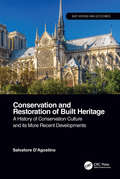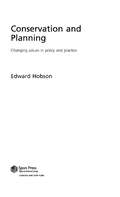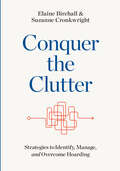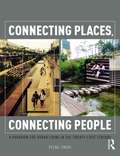- Table View
- List View
Construction Detailing for Landscape and Garden Design: Urban Water Features
by Paul HenseyFollowing on from the author’s previous book, Construction Detailing for Landscape and Garden Design: Surfaces, Steps and Margins, this book, Construction Detailing for Landscape and Garden Design: Urban Water Features, provides clear instruction for the construction of small to medium scale water features. With over 130 black and white CAD designs, Hensey provides guidance on a range of different water features such as drainage, water bowls and containers, walls and edges, structures and crossings, and rills, channels and cascades. This book offers technical references and a general knowledge of the basic principles, materials and techniques needed when engineering with water. This practical guide would be beneficial for garden designers and landscape architects seeking accessible and relatable materials for designing water features.
Construction Detailing for Landscape and Garden Design: Surfaces, steps and margins
by Paul HenseyDesigns for gardens and landscapes need to contain accurate information to ensure that both the designer’s intent is clear and to enable the highest quality constructions. This book contains the elements most often used when detailing surfaces, with key information on standards, guidance and construction that the practitioner must be aware of. Alongside the text are 2D and 3D images with suggestions of measurements, design considerations and materials. Key topics covered in this book are: Vehicular paving Pedestrian paving and patios Steps and ramps Margins, edges and kerbs Drainage channels To be used in conjunction with the book is an innovative online library of freely downloadable CAD (SketchUp format) details which link directly to those in the book. These details are available for the reader to edit, adapt and use in their own designs - and make the task of detailing for projects that little bit easier.
Construction Detailing for Interior Design: - with STUDIO
by PJ do Val"The amount of illustrations with straightforward explanation is a huge help." Cristina McCarthy, North Coast College, USA Improve your drafting skills and construction-documents literacy. With this book you can follow step-by-step details of interior elements, learn drafting terms, develop and customize details, create full construction document sets, and adhere to the 2015 International Building Codes and the 2010 Americans with Disabilities Act Accessibility Guidelines codes. Each chapter shows you key terms, Tips and Tricks, questions, equations, practical problems, and a sample plan with new elements. There's also an illustrated glossary.
Construction and Detailing for Interior Design Second Edition
by Drew PlunkettConstruction and detailing are vital skills for all students studying interior design and architecture. This book is structured to encourage a diversity of techniques, allowing each student the means to find and put into practice the appropriate solution to fabrication issues and also to express their own personal aesthetic. The relation of existing building shells to the construction and detailing of new elements is also explored. Practical tips are given throughout the book, the roles of consultants, manufacturers, suppliers, and fabricators are explained, and theories of modern, sustainable approaches to interior detailing are discussed. The chapters are packed with professional, annotated drawings and explanatory photographs of techniques, materials, and tools. Through these, the principles of sound construction are explained. This second edition includes revised diagrams to increase clarity, more on sustainability, and more on services and lighting.
Constructing Metropolitan Space: Actors, Policies and Processes of Rescaling in World Metropolises
by Jill Simone Gross Enrico Gualini Lin YeThere is little question today that processes of globalization affect national and local economies, governance processes, and conditions for economic competitiveness in the major urban regions of the world. In most liberal-democratic countries, these processes are occurring according to a rationale which attempts to combine strategies of state-supported development with increasing local-regional governmental decentralization and autonomy. Against this background, the issue of metropolitan development is being redefined worldwide, along with its institutional frameworks, modes of governance, policy instruments, and spatial planning strategies. The overarching assumption of this volume is that ‘metropolitan space’, far from being consolidated as a policy object, is currently being redefined and in some instances ‘constructed’ and contested as a scale, through a variety of policy practices related to spatial-economic development objectives. Through case studies drawn from across four continents, the authors reveal a range of interesting cross-national commonalities concerning the power that state actors, situated at various spatial scales, exert as agents in these processes. This volume interrogates key research issues raised by these developments, and is intended as a contribution to the establishment of a globally comparative analysis of the construction of metropolitan spaces and scales under conditions of globalization and neoliberalization.
Constructing Metropolitan Space: Actors, Policies and Processes of Rescaling in World Metropolises
by Jill Simone Gross Enrico Gualini Lin YeThere is little question today that processes of globalization affect national and local economies, governance processes, and conditions for economic competitiveness in the major urban regions of the world. In most liberal-democratic countries, these processes are occurring according to a rationale which attempts to combine strategies of state-supported development with increasing local-regional governmental decentralization and autonomy. Against this background, the issue of metropolitan development is being redefined worldwide, along with its institutional frameworks, modes of governance, policy instruments, and spatial planning strategies. The overarching assumption of this volume is that ‘metropolitan space’, far from being consolidated as a policy object, is currently being redefined and in some instances ‘constructed’ and contested as a scale, through a variety of policy practices related to spatial-economic development objectives. Through case studies drawn from across four continents, the authors reveal a range of interesting cross-national commonalities concerning the power that state actors, situated at various spatial scales, exert as agents in these processes. This volume interrogates key research issues raised by these developments, and is intended as a contribution to the establishment of a globally comparative analysis of the construction of metropolitan spaces and scales under conditions of globalization and neoliberalization.
Constructing a Consumer-Focused Industry: Cracks, Cladding and Crisis in the Residential Construction Sector (Social Value in the Built Environment)
by David Oswald Trivess MooreThe old saying ‘safe as houses’ is being challenged around the world like never before. Over recent decades homeowners have experienced the devastating effects of defects like asbestos, leaky buildings, structural failings, and more recently the combustible cladding crisis. The provision of safe and secure housing is a critical starting point to ensure that social value can be delivered in the built environment. However, some of these dangerous defects have resulted in a lack of security, safety, health, well-being, and social value for households and the wider community. The problems homeowners experience go beyond the substantial financial costs for defect rectification. Too often there has been a lack of government and industry support to help the housing consumer through these issues or to prevent them from occurring to begin with. It is time for a rethink and restructure of government policy, support, and industry practices to better protect housing consumers and deliver high-quality and sustainable housing that creates social value. Through evidence-based research and international case studies, this book focuses on the effects that dangerous defects have on the housing consumer. The ongoing construction cladding crisis is used as a primary case study throughout to highlight these implications, with other previous large-scale defect examples, such as leaky buildings and asbestos. Based upon the range of emerging evidence, we propose ideas for policy makers, construction and built environment professionals, owners corporations, and households on how to move forward towards a higher-quality, sustainable, and socially valuable way of residential living. Government policy has long focused on ‘making industry work’ through building regulations and standards. It is now time for greater government and industry focus on the consumer to make ‘consumer protection work’ in the built environment. There is a need to prevent dangerous defects like combustible cladding, better support consumers when defects emerge, and to create buildings for social value rather than minimum standards. Now is the time to build a better future for the end-user.
Constructing a Consumer-Focused Industry: Cracks, Cladding and Crisis in the Residential Construction Sector (Social Value in the Built Environment)
by David Oswald Trivess MooreThe old saying ‘safe as houses’ is being challenged around the world like never before. Over recent decades homeowners have experienced the devastating effects of defects like asbestos, leaky buildings, structural failings, and more recently the combustible cladding crisis. The provision of safe and secure housing is a critical starting point to ensure that social value can be delivered in the built environment. However, some of these dangerous defects have resulted in a lack of security, safety, health, well-being, and social value for households and the wider community. The problems homeowners experience go beyond the substantial financial costs for defect rectification. Too often there has been a lack of government and industry support to help the housing consumer through these issues or to prevent them from occurring to begin with. It is time for a rethink and restructure of government policy, support, and industry practices to better protect housing consumers and deliver high-quality and sustainable housing that creates social value. Through evidence-based research and international case studies, this book focuses on the effects that dangerous defects have on the housing consumer. The ongoing construction cladding crisis is used as a primary case study throughout to highlight these implications, with other previous large-scale defect examples, such as leaky buildings and asbestos. Based upon the range of emerging evidence, we propose ideas for policy makers, construction and built environment professionals, owners corporations, and households on how to move forward towards a higher-quality, sustainable, and socially valuable way of residential living. Government policy has long focused on ‘making industry work’ through building regulations and standards. It is now time for greater government and industry focus on the consumer to make ‘consumer protection work’ in the built environment. There is a need to prevent dangerous defects like combustible cladding, better support consumers when defects emerge, and to create buildings for social value rather than minimum standards. Now is the time to build a better future for the end-user.
Constructed Wetlands and Sustainable Development
by Gary Austin Kongjian YuThis book explains how with careful planning and design, the functions and performance of constructed wetlands can provide a huge range of benefits to humans and the environment. It documents the current designs and specifications for free water surface wetlands, horizontal and vertical subsurface flow wetlands, hybrid wetlands and bio retention basins; and explores how to plan, engineer, design and monitor these natural systems. Sections address resource management (landscape planning), technical issues (environmental engineering and botany), recreation and physical design (landscape architecture), and biological systems (ecology). Site and municipal scale strategies for flood management, storm-water treatment and green infrastructure are illustrated with case studies from the USA, Europe and China, which show how these principles have been put into practice. Written for upper level students and practitioners, this highly illustrated book provides designers with the tools they need to ensure constructed wetlands are sustainably created and well manage
Constructed Wetlands and Sustainable Development
by Gary Austin Kongjian YuThis book explains how with careful planning and design, the functions and performance of constructed wetlands can provide a huge range of benefits to humans and the environment. It documents the current designs and specifications for free water surface wetlands, horizontal and vertical subsurface flow wetlands, hybrid wetlands and bio retention basins; and explores how to plan, engineer, design and monitor these natural systems. Sections address resource management (landscape planning), technical issues (environmental engineering and botany), recreation and physical design (landscape architecture), and biological systems (ecology). Site and municipal scale strategies for flood management, storm-water treatment and green infrastructure are illustrated with case studies from the USA, Europe and China, which show how these principles have been put into practice. Written for upper level students and practitioners, this highly illustrated book provides designers with the tools they need to ensure constructed wetlands are sustainably created and well manage
Constructed Ecologies: Critical Reflections on Ecology with Design
by Margaret GroseToday, designers are shifting the practice of landscape architecture towards the need for a more complex understanding of ecological science. Constructed Ecologies presents ecology as critical theory for design, and provides major ideas for design that are supported with solid and imaginative science. In the questioning narrative of Constructed Ecologies, the author discards many old and tired theories in landscape architecture. With detailed documentation, she casts off the savannah theory, critiques the search for universals, reveals the needed role of designers in large-scale agriculture, abandons the overlay technique of McHarg, and introduces the ecological and urban health urgency of public night lighting. Margaret Grose presents wide-ranging new approaches and shows the importance of learning from science for design, of going beyond assumptions, of working in multiple rather than single issues, of disrupting linear design thinking, and of dealing with data. This book is written with a clear voice by an ecologist and landscape architect who has led design students into loving ecological science for the support it gives design.
Constructed Ecologies: Critical Reflections on Ecology with Design
by Margaret GroseToday, designers are shifting the practice of landscape architecture towards the need for a more complex understanding of ecological science. Constructed Ecologies presents ecology as critical theory for design, and provides major ideas for design that are supported with solid and imaginative science. In the questioning narrative of Constructed Ecologies, the author discards many old and tired theories in landscape architecture. With detailed documentation, she casts off the savannah theory, critiques the search for universals, reveals the needed role of designers in large-scale agriculture, abandons the overlay technique of McHarg, and introduces the ecological and urban health urgency of public night lighting. Margaret Grose presents wide-ranging new approaches and shows the importance of learning from science for design, of going beyond assumptions, of working in multiple rather than single issues, of disrupting linear design thinking, and of dealing with data. This book is written with a clear voice by an ecologist and landscape architect who has led design students into loving ecological science for the support it gives design.
Constructed Climates: A Primer on Urban Environments
by William G. WilsonAs our world becomes increasingly urbanized, an understanding of the context, mechanisms, and consequences of city and suburban environments becomes more critical. Without a sense of what open spaces such as parks and gardens contribute, it’s difficult to argue for their creation and maintenance: in the face of schools needing resources, roads and sewers needing maintenance, and people suffering at the hands of others, why should cities and counties spend scarce dollars planting trees and preserving parks? In Constructed Climates, ecologist William G. Wilson demonstrates the value of urban green. Focusing specifically on the role of vegetation and trees, Wilson shows the costs and benefits reaped from urban open spaces, from cooler temperatures to better quality ground water—and why it all matters. While Constructed Climates is a work of science, it does not ignore the social component. Wilson looks at low-income areas that have poor vegetation, and shows how enhancing these areas through the planting of community gardens and trees can alleviate social ills. This book will be essential reading for environmentalists and anyone making decisions for the nature and well-being of our cities and citizens.
Constructed Climates: A Primer on Urban Environments
by William G. WilsonAs our world becomes increasingly urbanized, an understanding of the context, mechanisms, and consequences of city and suburban environments becomes more critical. Without a sense of what open spaces such as parks and gardens contribute, it’s difficult to argue for their creation and maintenance: in the face of schools needing resources, roads and sewers needing maintenance, and people suffering at the hands of others, why should cities and counties spend scarce dollars planting trees and preserving parks? In Constructed Climates, ecologist William G. Wilson demonstrates the value of urban green. Focusing specifically on the role of vegetation and trees, Wilson shows the costs and benefits reaped from urban open spaces, from cooler temperatures to better quality ground water—and why it all matters. While Constructed Climates is a work of science, it does not ignore the social component. Wilson looks at low-income areas that have poor vegetation, and shows how enhancing these areas through the planting of community gardens and trees can alleviate social ills. This book will be essential reading for environmentalists and anyone making decisions for the nature and well-being of our cities and citizens.
Constructed Climates: A Primer on Urban Environments
by William G. WilsonAs our world becomes increasingly urbanized, an understanding of the context, mechanisms, and consequences of city and suburban environments becomes more critical. Without a sense of what open spaces such as parks and gardens contribute, it’s difficult to argue for their creation and maintenance: in the face of schools needing resources, roads and sewers needing maintenance, and people suffering at the hands of others, why should cities and counties spend scarce dollars planting trees and preserving parks? In Constructed Climates, ecologist William G. Wilson demonstrates the value of urban green. Focusing specifically on the role of vegetation and trees, Wilson shows the costs and benefits reaped from urban open spaces, from cooler temperatures to better quality ground water—and why it all matters. While Constructed Climates is a work of science, it does not ignore the social component. Wilson looks at low-income areas that have poor vegetation, and shows how enhancing these areas through the planting of community gardens and trees can alleviate social ills. This book will be essential reading for environmentalists and anyone making decisions for the nature and well-being of our cities and citizens.
Conservatory and Greenhouse Gardening (Collins Practical Gardener)
by Lia LeendertzWhether it's a small citrus plant or a large vine, conservatory plants are more popular than ever. Collins Practical Gardener Conservatory & Greenhouse Gardening is bursting with practical advice and step-by-step instructions covering everything from choosing and planning a structure to filling it full of plants and keeping them thriving.
Conservation in the Age of Consensus
by John PendleburyThis new text on the subject of conservation in the built environment provides a unique holistic view on the understanding of the practice of conservation connecting it with wider societal and political forces. UK practice is used as a means, along with international examples, for bringing together a real understanding of practice with a social science analysis of the issues. The author introduces ideas about the meanings and values attached to historic environments and how that translates into public policies of conservation.
Conservation in the Age of Consensus
by John PendleburyThis new text on the subject of conservation in the built environment provides a unique holistic view on the understanding of the practice of conservation connecting it with wider societal and political forces. UK practice is used as a means, along with international examples, for bringing together a real understanding of practice with a social science analysis of the issues. The author introduces ideas about the meanings and values attached to historic environments and how that translates into public policies of conservation.
Conservation and Restoration of Built Heritage: A History of Conservation Culture and its More Recent Developments (Built Heritage and Geotechnics)
by Salvatore D'AgostinoThe word conservation, when used in the context of the preservation of built heritage, implies an intrinsically complex concept that evolved over time, since it has been influenced by the perception of history throughout time. This volume emphasises why an understanding of the cultural evolution of the conservation approach must be considered a prerequisite for architects and engineers if they are to cooperate in full harmony with historic-artistic culture for the preservation of global built heritage. In particular, the volume highlights how, during the second half of the last century, the preservation process also involved engineering – the science of making practical applications of knowledge – which, for a long time, made an uncritical use of techniques and materials and devised interventions on historical heritage that were heavily invasive. The volume also devotes special attention to the problems related to seismic risk, to which Italy, Greece and Portugal are particularly prone. Problems that emerge during the crisis and reconstruction phases are dealt with in detail, as is scheduled maintenance, as this latter approach always constitutes an improvement in the performance of the monument and is the most appropriate tool for the conservation of the built heritage. Finally, the volume collects examples of building restoration with case studies of many outstanding monuments. The work will appeal to professionals and academics in the broader fields of civil engineering (both geotechnical and structural engineering), architecture, art history, the history of architecture, restoration and cultural heritage management. This book will: Provide a critical reading of the history of conservation; Discuss materials and techniques of ancient architecture; Cover seismic vulnerability and preservation of the historic integrity of the monument; Advocate an approach based on programmed maintenance; Feature numerous case histories, including St Mark’s Basilica in Venice and the complex restoration of the cathedral of Notre-Dame in Paris.
Conservation and Restoration of Built Heritage: A History of Conservation Culture and its More Recent Developments (Built Heritage and Geotechnics)
by Salvatore D'AgostinoThe word conservation, when used in the context of the preservation of built heritage, implies an intrinsically complex concept that evolved over time, since it has been influenced by the perception of history throughout time. This volume emphasises why an understanding of the cultural evolution of the conservation approach must be considered a prerequisite for architects and engineers if they are to cooperate in full harmony with historic-artistic culture for the preservation of global built heritage. In particular, the volume highlights how, during the second half of the last century, the preservation process also involved engineering – the science of making practical applications of knowledge – which, for a long time, made an uncritical use of techniques and materials and devised interventions on historical heritage that were heavily invasive. The volume also devotes special attention to the problems related to seismic risk, to which Italy, Greece and Portugal are particularly prone. Problems that emerge during the crisis and reconstruction phases are dealt with in detail, as is scheduled maintenance, as this latter approach always constitutes an improvement in the performance of the monument and is the most appropriate tool for the conservation of the built heritage. Finally, the volume collects examples of building restoration with case studies of many outstanding monuments. The work will appeal to professionals and academics in the broader fields of civil engineering (both geotechnical and structural engineering), architecture, art history, the history of architecture, restoration and cultural heritage management. This book will: Provide a critical reading of the history of conservation; Discuss materials and techniques of ancient architecture; Cover seismic vulnerability and preservation of the historic integrity of the monument; Advocate an approach based on programmed maintenance; Feature numerous case histories, including St Mark’s Basilica in Venice and the complex restoration of the cathedral of Notre-Dame in Paris.
Conservation and Planning: Changing Values in Policy and Practice
by Edward HobsonConserving historic buildings continues to excite and inflame opinion. The means of protecting such buildings and areas are well established but frequently suffer a lack of wider understanding. Conservation and Planning takes a detailed look at the way these processes have evolved and their use today by policy makers and local decision makers.This book presents original research into how national and local decision-makers construct and implement conservation of the built environment. The findings in this book challenge many of the assumptions supporting conservation.
Conservation and Planning: Changing Values in Policy and Practice
by Edward HobsonConserving historic buildings continues to excite and inflame opinion. The means of protecting such buildings and areas are well established but frequently suffer a lack of wider understanding. Conservation and Planning takes a detailed look at the way these processes have evolved and their use today by policy makers and local decision makers.This book presents original research into how national and local decision-makers construct and implement conservation of the built environment. The findings in this book challenge many of the assumptions supporting conservation.
Conquer the Clutter: Strategies to Identify, Manage, and Overcome Hoarding
by Elaine Birchall Suzanne CronkwrightWhy does Cliff, a successful lawyer who regularly wins landmark cases, step over two-foot piles of paper whenever he opens his front door? Why do Joan and Paul ask Children's Services to take their three children instead of decluttering their home? Why does Lucinda feel intense pressure to hold onto her family's heirlooms even though she has no room for them? They have hoarding disorder, which an estimated 2% to 6% of the adult population worldwide experience.Conquer the Clutter offers hope to anyone affected by hoarding. Real-life vignettes, combined with easy-to-use assessment and intervention tools, support those who hoard—and those who care about them. Written by Elaine Birchall, a social worker dedicated to helping people declutter and achieve long-term control over their belongings, the book• provides an overview of hoarding, defining what it is—and is not• explains the difference between clutter and hoarding • describes different types of hoarding in detail, including impulse shopping, "closet" hoarding, and animal hoarding• debunks myths about hoarding and hoarders • explores the effects that hoarding has on relationships, on work, and on physical and financial health• presents a practical, step-by-step plan of action for decluttering• contains dedicated advice from individuals who have successfully overcome their hoarding disorderThe most comprehensive work about hoarding on the market, Conquer the Clutter discusses special populations who are not often singled out, such as the disabled and the elderly, and includes numerous worksheets to assist individuals in determining the scope of their hoarding disorder and tackling the problem.
Conquer the Clutter: Strategies to Identify, Manage, and Overcome Hoarding
by Elaine Birchall Suzanne CronkwrightWhy does Cliff, a successful lawyer who regularly wins landmark cases, step over two-foot piles of paper whenever he opens his front door? Why do Joan and Paul ask Children's Services to take their three children instead of decluttering their home? Why does Lucinda feel intense pressure to hold onto her family's heirlooms even though she has no room for them? They have hoarding disorder, which an estimated 2% to 6% of the adult population worldwide experience.Conquer the Clutter offers hope to anyone affected by hoarding. Real-life vignettes, combined with easy-to-use assessment and intervention tools, support those who hoard—and those who care about them. Written by Elaine Birchall, a social worker dedicated to helping people declutter and achieve long-term control over their belongings, the book• provides an overview of hoarding, defining what it is—and is not• explains the difference between clutter and hoarding • describes different types of hoarding in detail, including impulse shopping, "closet" hoarding, and animal hoarding• debunks myths about hoarding and hoarders • explores the effects that hoarding has on relationships, on work, and on physical and financial health• presents a practical, step-by-step plan of action for decluttering• contains dedicated advice from individuals who have successfully overcome their hoarding disorderThe most comprehensive work about hoarding on the market, Conquer the Clutter discusses special populations who are not often singled out, such as the disabled and the elderly, and includes numerous worksheets to assist individuals in determining the scope of their hoarding disorder and tackling the problem.
Connecting Places, Connecting People: A Paradigm for Urban Living in the 21st Century
by Reena TiwariWhat is a better community? How can we reconfigure places and transport networks to create environmentally friendly, economically sound, and socially just communities? How can we meet the challenges of growing pollution, depleting fossil fuels, rising gasoline prices, traffic congestion, traffic fatalities, increased prevalence of obesity, and lack of social inclusion? The era of car-based planning has led to the disconnection of people and place in developed countries, and is rapidly doing so in the developing countries of the Global South. The unfolding mega-trend in technological innovation, while adding new patterns of future living and mobility in the cities, will question the relevance of face-to-face connections. What will be the ‘glue’ that holds communities together in the future? To build better communities and to build better cities, we need to reconnect people and places. Connecting Places, Connecting People offers a new paradigm for place making by reordering urban planning principles from prioritizing movement of vehicles to focusing on places and the people who live in them. Numerous case studies, including many from developing countries in the Global South, illustrate how this can be realized or fallen short of in practical terms. Importantly, citizens need to be engaged in policy development, to connect with each other and with government agencies. To measure the connectivity attributes of places and the success of strategies to meet the needs, an Audit Tool is offered for a continual quantitative and qualitative evaluation.
